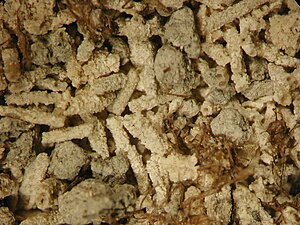
Amorphous calcium carbonate (ACC) is the amorphous and least stable polymorph of calcium carbonate. ACC is extremely unstable under normal conditions and is found naturally in taxa as wide-ranging as sea urchins, corals, mollusks, and foraminifera.[1][2][3] It is usually found as a monohydrate, holding the chemical formula CaCO3·H2O; however, it can also exist in a dehydrated state, CaCO3. ACC has been known to science for over 100 years when a non-diffraction pattern of calcium carbonate was discovered by Sturcke Herman, exhibiting its poorly-ordered nature.[4]
ACC is an example of crystallization by particle attachment (CPA), where crystals form via the addition of particles ranging from multi-ion complexes to fully formed nanocrystals.[5] Research of such systems have diverse application; however, the current lack of unambiguous answers to fundamental questions (i.e. solubility product, interfacial forces, structure, etc.) causes them to be topics of study in fields ranging from chemistry, geology, biology, physics, and materials science engineering.[6][5]
- ^ Politi, Yael; Arad, Talmon; Klein, Eugenia; Weiner, Steve; Addadi, Lia (2004-11-12). "Sea Urchin Spine Calcite Forms via a Transient Amorphous Calcium Carbonate Phase". Science. 306 (5699): 1161–1164. Bibcode:2004Sci...306.1161P. doi:10.1126/science.1102289. ISSN 0036-8075. PMID 15539597. S2CID 32902672.
- ^ Addadi, L.; Raz, S.; Weiner, S. (2003-06-17). "Taking Advantage of Disorder: Amorphous Calcium Carbonate and Its Roles in Biomineralization". Advanced Materials. 15 (12): 959–970. doi:10.1002/adma.200300381. ISSN 1521-4095. S2CID 96531039.
- ^ Giuffre, Anthony J.; Gagnon, Alexander C.; De Yoreo, James J.; Dove, Patricia M. (2015-09-15). "Isotopic tracer evidence for the amorphous calcium carbonate to calcite transformation by dissolution–reprecipitation". Geochimica et Cosmochimica Acta. 165: 407–417. Bibcode:2015GeCoA.165..407G. doi:10.1016/j.gca.2015.06.002. ISSN 0016-7037.
- ^ US patent 603225, Sturcke, Herman E., "Process of preparing amorphous carbonate of lime from residues", issued April 26, 1898
- ^ a b Cite error: The named reference
:6was invoked but never defined (see the help page). - ^ Cite error: The named reference
:7was invoked but never defined (see the help page).